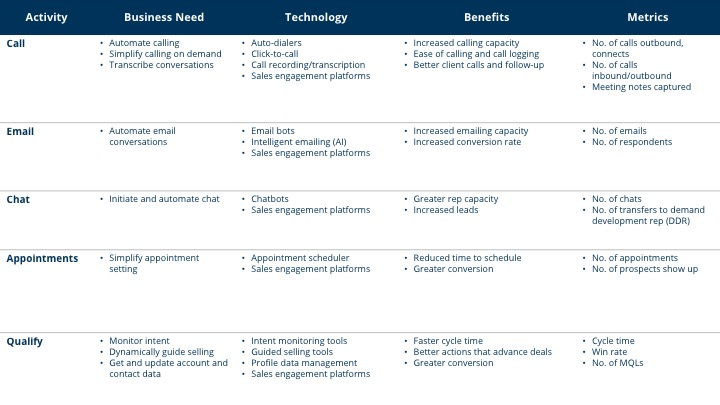Technology and Sales Productivity, Part One: Business Development
- Revenue ops and sales ops leaders should make understanding the latest sales technology innovation part of their jobs
- Five key activities help determine what technology can be leveraged in the business development phase of the sales cycle
- Sales engagement platforms provide a breadth of functionality that revs up sales productivity
If you attended SiriusDecisions Summit a few weeks ago, you probably heard a lot about the revenue engine (marketing, sales and customer success). If you found your way to Robert Muñoz’s and my presentation – “Revving Your Revenue Engine With the Sales Technology Stack” – you heard quite a bit about the technology that supports sales productivity.
Good revenue operations or sales operations leaders have to make understanding technology advancements part of their job. Technology is innovating so quickly that if you’re just watching from the sidelines, your sales team’s productivity will suffer, leaving you at a competitive disadvantage. Sales organizations can leverage technology to rev the revenue engine and gain productivity across three core user groups – business development, opportunity management and sales management.
This blog post takes a look at the first of these – business development. Business development reps (BDRs), a team that includes inbound telequalifiers and outbound teleprospectors, are responsible for prospecting, nurturing and qualifying leads, scheduling appointments and finally passing leads to an account executive in hopes that the qualified lead will be accepted by sales, further qualified, developed and then closed. The BDR’s responsibilities can be distilled into core activities and associated business needs (see table below) that can be addressed by technologies that provide tangible and measurable productivity benefits like an increased number of appointments and qualified leads, shorter cycle times and increased conversion rates. The table includes sample metrics that can be used to show productivity improvements. Of course, you need to establish a baseline for productivity (e.g. average number of outbound calls per rep) before and after implementing a new technology. A sales activity study is a great way to establish that baseline for the sales organization.

Note that the business need determine the technology you can use to enhance productivity. Many of these technologies – e.g. auto-dialers, click-to-call, automated call transcription, bots and schedulers –work to automate or semi-automate part of the sales process.
For example, chatbots powered by AI can initiate simple conversations with online prospects, then determine their main needs and interests and, when appropriate, hand off the prospect to a BDR (or demand development rep) who can jump into the chat to initiate human-to-human contact. Appointment scheduling applications and functionality also allow a BDR (or an intelligent email bot) to get in touch with the prospect in a timely manner offering multiple dates/times to speak to an account executive. Offering a simple “click to schedule” functionality eliminates the time involved in scheduling appointments via traditional back and forth email or calling. The prospect clicks the preferred time and voilà – the meeting is scheduled, confirmations are sent out and calendars updated.
Intent monitoring solutions can help prioritize which leads BDRs should work to qualify on the basis of their interest and intent signals about products and services your organization can provide. High-volume omni-channel interactions can be streamlined effectively with workflows and intelligence that help to prioritize and establish a cadence of calls, emails and actions to be taken that increase the customer experience and sales productivity.
Growing in popularity among B2B sales organizations is the use of sales engagement platforms that bring several of the technologies and functionalities outlined above into a single platform that is integrated with major email, calendar and sales force automation (SFA) systems to help automate data recording and improve workflows. Automatically recording administrative sales tasks and reducing the time spent on them increases sales reps’ efficiency. The activity data captured can be leveraged with AI to advise on next best steps. For more details on these platforms, see my blog post “The Four Core Functionalities of Sales Engagement Technology.”
There’s a lot of opportunity to boost the productivity of the business development function with sales-specific technology. This technology is rapidly gaining capabilities and functionality and has the potential to impact the volume of demand generated, conversion rates and the cycle time of leads moving to the opportunity stage. In subsequent blog posts we’ll discuss how technology can help in the areas of opportunity management and sales management.
Read now: “Technology and Sales Productivity, Part 2: Opportunity Management”